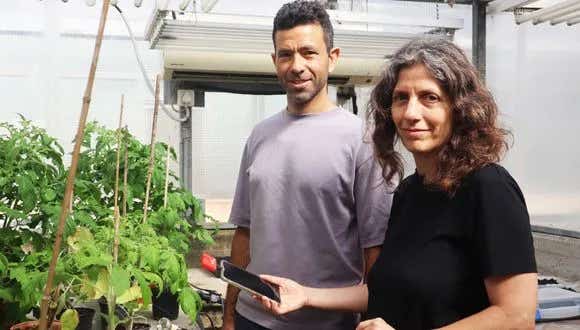Global first: Researchers discover that plants emit sounds
For the first time in the world, researchers at Tel Aviv University recorded and analyzed sounds distinctly emitted by plants.

[May 21, 2023: Noga Shahar, Tel-Aviv University]
Left to right: Prof. Yossi Yovel and Prof. Lilach Hadany. (CREDIT: Tel Aviv University)
Plants exhibit significant changes in their phenotypes in response to stress. They differ visually, with respect to both color and shape, from unstressed plants. They also emit volatile organic compounds (VOCs), e.g. when exposed to drought or herbivores.
VOCs can also affect neighboring plants, resulting in increased resistance in these plants. Altogether, plants have been demonstrated to produce visual, chemical, and tactile cues, which other organisms can respond to. Nevertheless, the ability of plants to emit airborne sounds—that could potentially be heard by other organisms—has not been sufficiently explored. Until now.
For the first time in the world, researchers at Tel Aviv University recorded and analyzed sounds distinctly emitted by plants. The click-like sounds, similar to the popping of popcorn, are emitted at a volume similar to human speech, but at high frequencies, beyond the hearing range of the human ear.
The researchers: "We found that plants usually emit sounds when they are under stress, and that each plant and each type of stress is associated with a specific identifiable sound. While imperceptible to the human ear, the sounds emitted by plants can probably be heard by various animals, such as bats, mice, and insects."
Related Stories
The study was led by Prof. Lilach Hadany from the School of Plant Sciences and Food Security at the Wise Faculty of Life Sciences, together with Prof. Yossi Yovel, Head of the Sagol School of Neuroscience and faculty member at the School of Zoology and the Steinhardt Museum of Natural History, and research students Itzhak Khait and Ohad Lewin-Epstein, in collaboration with researchers from the Raymond and Beverly Sackler School of Mathematical Sciences, the Institute for Cereal Crops Research, and the Sagol School of Neuroscience – all at Tel Aviv University. The paper was published in the prestigious scientific journal Cell.
Prof. Hadany: "From previous studies we know that vibrometers attached to plants record vibrations. But do these vibrations also become airborne soundwaves - namely sounds that can be recorded from a distance? Our study addressed this question, which researchers have been debating for many years."
At the first stage of the study the researchers placed plants in an acoustic box in a quiet, isolated basement with no background noise. Ultrasonic microphones recording sounds at frequencies of 20-250 kilohertz (the maximum frequency detected by a human adult is about 16 kilohertz) were set up at a distance of about 10cm from each plant. The study focused mainly on tomato and tobacco plants, but wheat, corn, cactus and henbit were also recorded.
Prof. Hadany: "Before placing the plants in the acoustic box we subjected them to various treatments: some plants had not been watered for five days, in some the stem had been cut, and some were untouched. Our intention was to test whether the plants emit sounds, and whether these sounds are affected in any way by the plant's condition.
Our recordings indicated that the plants in our experiment emitted sounds at frequencies of 40-80 kilohertz. Unstressed plants emitted less than one sound per hour, on average, while the stressed plants – both dehydrated and injured – emitted dozens of sounds every hour."
The research team including Prof. Yossi Yovel and Prof. Lilach Hadany. (CREDIT: Tel Aviv University)
The recordings collected in this way were analyzed by specially developed machine learning (AI) algorithms. The algorithms learned how to distinguish between different plants and different types of sounds, and were ultimately able to identify the plant and determine the type and level of stress from the recordings.
Moreover, the algorithms identified and classified plant sounds even when the plants were placed in a greenhouse with a great deal of background noise. In the greenhouse the researchers monitored plants subjected to a process of dehydration over time and found that the quantity of sounds they emitted increased up to a certain peak, and then diminished.
Prof. Hadany: "In this study we resolved a very old scientific controversy: we proved that plants do emit sounds! Our findings suggest that the world around us is full of plant sounds, and that these sounds contain information – for example about water scarcity or injury. We assume that in nature the sounds emitted by plants are detected by creatures nearby, such as bats, rodents, various insects, and possibly also other plants - that can hear the high frequencies and derive relevant information."
Prof. Hadany continued: "We believe that humans can also utilize this information, given the right tools - such as sensors that tell growers when plants need watering. Apparently, an idyllic field of flowers can be a rather noisy place. It's just that we can't hear the sounds!"
In future studies the researchers will continue to explore a range of intriguing questions: What is the mechanism behind plant sounds? How do moths detect and react to sounds emitted by plants? Do other plants also hear these sounds? And more…
Summary:
The sounds emitted by plants are ultrasonic, beyond the hearing range of the human ear.
Plant sounds are informative: mostly emitted when the plant is under stress, they contain information about its condition.
The researchers mainly recorded tomato and tobacco plants; wheat, corn, cactus, and henbit were also recorded.
The researchers: "Apparently, an idyllic field of flowers can be a rather noisy place. It's just that we can't hear the sounds!"
For more environmental news stories check out our Green Impact section at The Brighter Side of News.
Note: Materials provided above by Tel-Aviv University. Content may be edited for style and length.
Like these kind of feel good stories? Get the Brighter Side of News' newsletter.
Joseph Shavit
Head Science News Writer | Communicating Innovation & Discovery
Based in Los Angeles, Joseph Shavit is an accomplished science journalist, head science news writer and co-founder at The Brighter Side of News, where he translates cutting-edge discoveries into compelling stories for a broad audience. With a strong background spanning science, business, product management, media leadership, and entrepreneurship, Joseph brings a unique perspective to science communication. His expertise allows him to uncover the intersection of technological advancements and market potential, shedding light on how groundbreaking research evolves into transformative products and industries.



